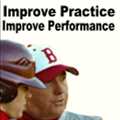It's the last inning of the baseball game. Though it's seesawed
during the entire game, the score is now tied. A runner is standing on each of the bases around the diamond. There is one
strike and three balls. The pitcher nods, winds up, and then flings the ball towards the catcher's glove. "Strike!" the empire
yells as the batter's swing misses the ball by a hair. The next pitch could decide the result of the game! But then the coach
of the pitcher's team climbs out of the dugout, and calls a timeout by forming a "T" with his hands. He then strolls to the
pitcher's mound. The coach informs the youngster that another pitcher will relieve him.
Since it's not due to poor performance, what's the reason? The pitch for fewer pitches Baseball is "America's pastime"
and is popular throughout the country, such as in Amish Country in Ohio. This is evident in the numerous Little League teams
that represent areas throughout U.S.—and even internationally. Sports not only develop a love for sports in children,
but also other facets of growing up. It teaches them the importance of self-discipline and striving to succeed.
Sports also nurture socialization skills through cooperation, competition and sportsmanship. And, of course, playing sports
is good exercise. However, children's bodies are still growing, and aren't as durable as adult athletes'. That's why since
the 2007 season, the Little League has standardized the workload of pitchers based on the number of pitches they've made.
That's opposed to the number of innings they've pitched. For example, children who are 10-years-old or younger cannot pitch
more than 75 times during a game. This move makes sense.
Unlike sports such as football, basketball and soccer, baseball isn't a timed game. Theoretically, one inning could include
an unlimited number of pitches! That causes youngster pitchers become very vulnerable to arm injuries. In fact, based on research
that the American Sports Medicine Institute conducted, the top gauge of possible arm injuries for pitchers was due to the
number of pitches made. It doesn't hurt to prevent pain If you have a child who plays organized sports--in Amish Country in
Ohio or elsewhere--here are some guidelines to help prevent sports injuries:
1. Children should not play when they are in pain or have been injured. Letting your child rest and play with plush sports
balls for a while isn't a sign of cowardice.
2. Healthy diets are important to build strong bones. In particular, protein, dairy products, vegetables, and fruits are
vital for creating sturdy bones.
3. Children must always wear sports protective gear that fits well. It's very important that your child also wears equipment
that's designed for the particular sport that he or she plays. For example, soccer cleats shouldn't be worn for football,
etc.
4. Coaches and parents should learn the physiology and body mechanics related to particular sports. For example, discover
which stretching techniques and body positions are most effective in safeguarding the child from injuries.
5. Kids should do warm-ups and cool-downs carefully. These stretches are important to avoid muscle spasms and to improve
body mechanics.
6. Youngsters need (chiropractic) adjustments that press and move the joints, to treat injuries
7. Kids must be taught to obey the rules of the sport. Failing to play by the rules can result in more fouls and injuries.
Sports provide an array of benefits for kids in Amish Country in Ohio, and throughout the world. The love for sports is so
strong in some kids that they even play with plush sports balls when they're not on the field. That's okay. But as a parent,
it's important that you're a good sport and help to prevent sports injuries in your child.
for more information on

